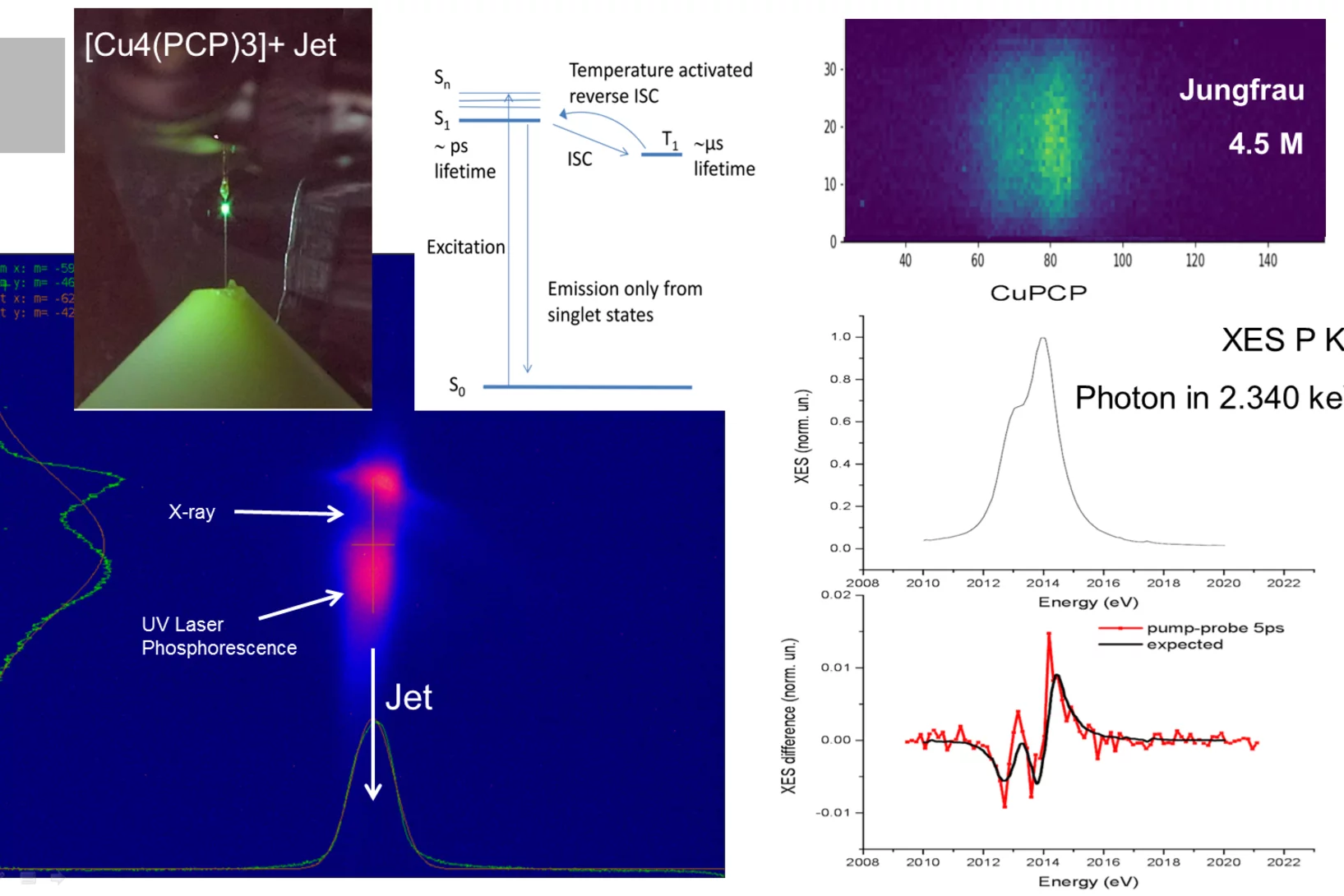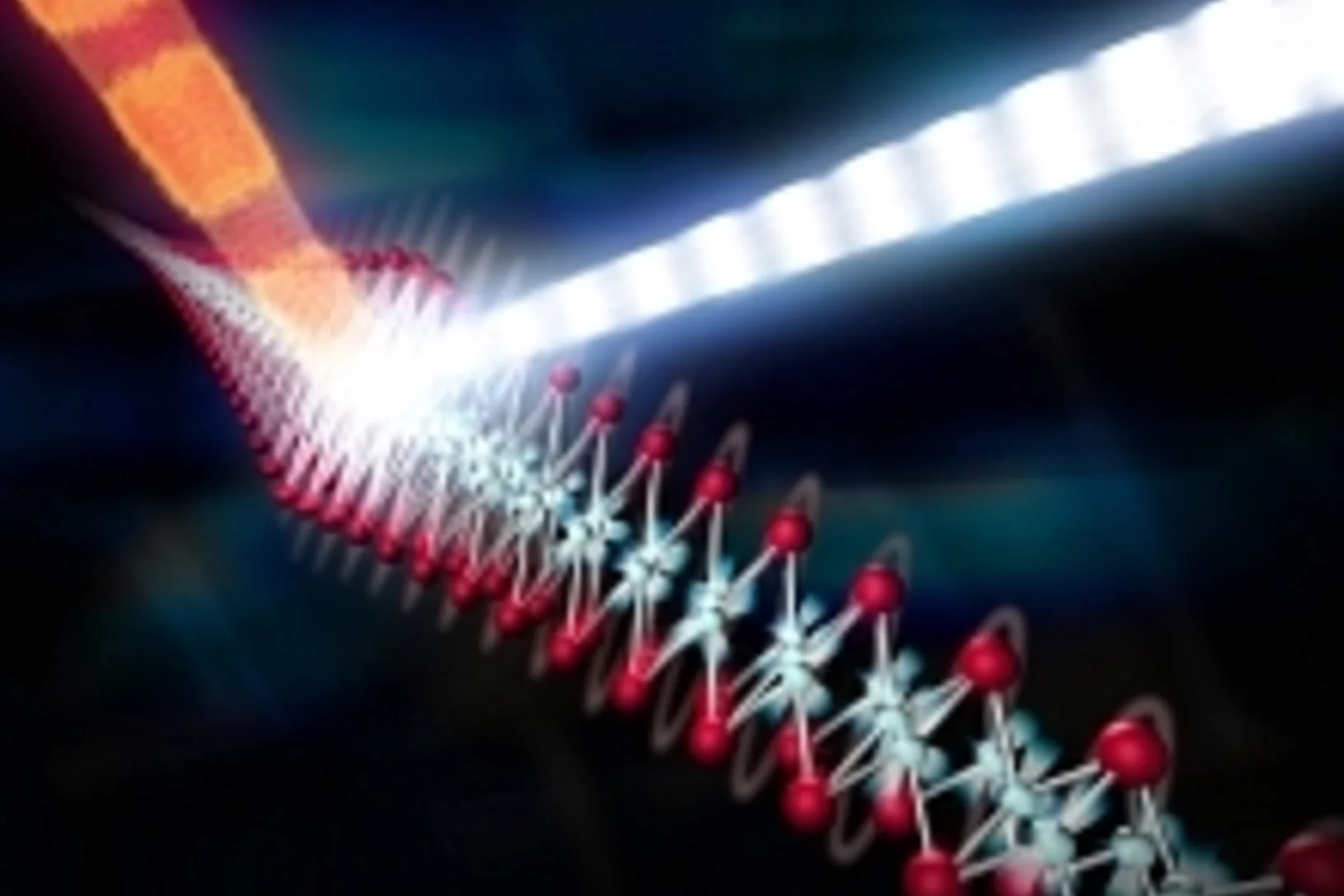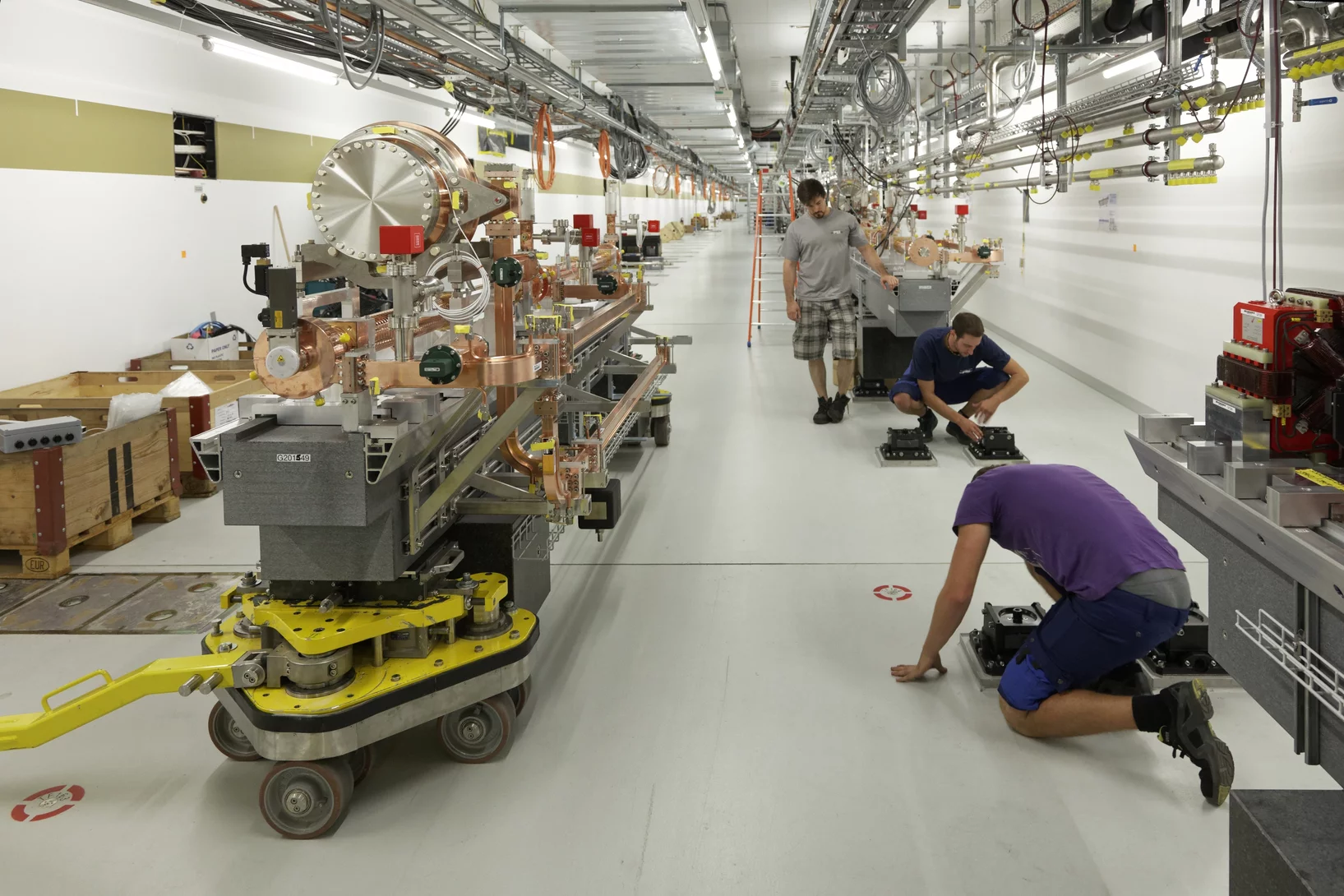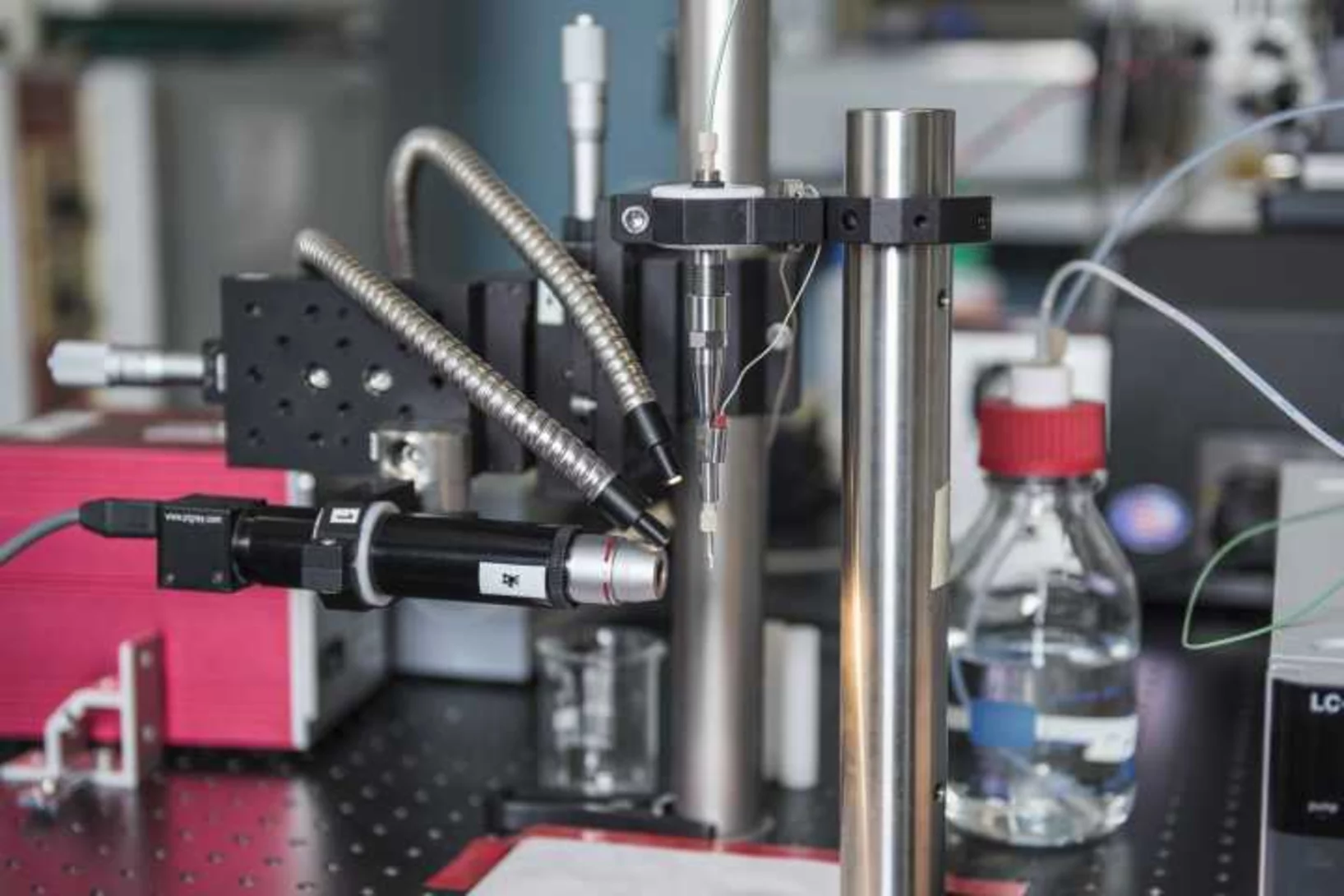First Pilot Experiment at SwissFEL-Alvra on UV photo-induced charge transfer in OLED system
On the 17th of December 2017 SwissFEL saw its first pilot experiment in the Alvra experimental station of the SwissFEL ARAMIS beamline. A team of scientists from the University of Bremen, Krakow and PSI, led by Matthias Vogt (Univ. Bremen) and Chris Milne (PSI)in collaboration with J. Szlachetko, J. Czapla-Masztafiak, W. M. Kwiatek (Inst. of Nucl.Phys. PAN (Krakow), successfully did the first pilot experiment at SwissFEL-Alvra on UV photo-induced charge transfer in OLED system.
Erstes Experiment am SwissFEL erfolgreich durchgeführt
Die Jahre des sorgsamen Planens und Aufbauens haben sich ausgezahlt: An der neuesten Grossforschungsanlage des Paul Scherrer Instituts PSI – dem Freie-Elektronen-Röntgenlaser SwissFEL – wurde das erste Experiment erfolgreich durchgeführt. Damit wurden zwei Ziele erreicht: Erstens gibt es schon gleich ein neues wissenschaftliches Ergebnis. Zweitens wird damit das Zusammenspiel der vielen Einzelkomponenten der hochkomplexen Anlage optimiert.
First time resolved Pilot Experiment by SwissFEL: Semiconductor to metal transition in Ti3O5 nanocrystals
On the 30th of November 2017 SwissFEL saw its first time resolved pilot experiment in the Bernina experimental station of the SwissFEL ARAMIS beamline. A team of scientists from the University of Rennes, ESRF and PSI, led by Marco Cammarata (Univ. Rennes) and Henrik Lemke (PSI), successfully started the experimental phase at SwissFEL. The goal was to study the picosecond dynamics of a light-induced phase transition from a semiconductor to metallic crystal structure in a Titanium Oxide (D).
How ‘super-microscopes’ are changing the face of European science
13 November 2017 – Brussels – 16 organisations representing 19 light sources facilities across Europe gathered to launch the LEAPS initiative and signed an agreement to strengthen their collaboration, in the presence of Robert-Jan Smits, Director General for Research and Innovation (RTD) at the European Commission, and Giorgio Rossi, Chair of the European Strategy Forum on Research Infrastructures (ESFRI).
First light in SwissFEL Experimental Station Bernina
Friday, October 20th, 2017, we brought the first light (wavelength 1.2 nm) into the experimental hutch of Bernina.
The beam passed the Alvra endstation, went through the diagnostic devices and hit the diagnostic screen in front of the refocussing KB-system of Bernina.
The upper picture shows the pink beam on the last diagnostic screen of the beamline.
The lower left at the entrance of Bernina-hutch, 133 m downstream of the undulator.
ATHOS Conceptual Design Report (CDR)
The ATHOS Conceptual Design Report has recently been completed and describes the ATHOS project in detail. The CDR starts with a summary of the characteristics of the ATHOS undulator line. Especially the design parameters of the different ATHOS operation modes are explained and illustrated by simulation results. The core part of the report is a description of all key components, i.e. from the electron bunch extraction kicker down to the ATHOS experimental stations.Download the full report Athos CDR .
First beam in optics hutch
On August 31st, 2017, SwissFEL reached the next milestone by sending the first X-rays into the Optics Hutch. The Aramis undulators of SwissFEL produced SASE-radiation with 1.2 nm wavelength.
Scientists get first direct look at how electrons ‘dance’ with vibrating atoms
Research experience from California's X-ray free-electron laser benefits SwissFEL. It's the camera that allows researchers to make extremely rapid processes visible: the X-ray free-electron laser. Currently, however, only three sites worldwide—in the US, Japan and South Korea—have facilities capable of carrying out such measurements. Two current articles in Science and Nature Communications co-authored by researchers now at the Paul Scherrer Institute PSI exemplify the kind of outstanding scientific work that can be carried out at such facilities, enabling new insights into the mechanisms of superconductors and magnetic switching in molecules. The measurements were conducted at the Linac Coherent Light Source (LCLS) free-electron laser in California. Press release PSI / Press release SLAC
Observing switching of Molecules using Free Electron Lasers
Free electron lasers (FELs) like SwissFEL help scientists to understand the mechanisms that switch properties of materials which are the basis for functions in electronics, solar cells, chemistry and biology. By using ultrashort X-ray pulses it becomes possible to visualize the ultrafast rearrangements of electrons and atoms that enable the properties to switch in molecules or crystals. An international consortium of researchers lead by Paul Scherrer Institute, Université de Rennes, and SLAC National Laboratory has now visualized the entire cascade of processes that lead to a change of the magnetic moment of electrons in a molecule within one trillionth of a second (10-12 s = 1 picosecond), using the FEL at Stanford, California (LCLS).
First lasing at a wavelength of 4.1 nm
The electron beam energy of SwissFEL was recently increased to above 900 MeV by successfully bringing two new accelerating modules into operation. This allowed SwissFEL to produce laser radiation for the first time in the soft x-ray regime with a photon wavelength of 4.1 nm. During the next months, the electron beam energy will be progressively further increased with the goal of enabling first user experiments at a wavelength of around 0.5 nm towards the end of this year.
SwissFEL First Lasing
On Friday December 2nd at 1am SwissFEL observed for the first time FEL lasing in the undulator line. The lasing was achieved with a commission beam of low intensity, repetition rate and energy, i.e. 100pC/bunch, 1Hz and 377MeV. The 12 undulators were set to a K value of 1.2. The resulting wavelength computed from beam energy and undulator K value is 24nm. The FEL signal was observed with a Si-diode detector. The spontaneous radiation signal with uncompressed electron beam increased by a large factor when the beam was compressed from 10ps to about 1ps at constant charge and electron beam energy. By opening the undulator gaps a first FEL gain curve was measured.
Extreme optical and electronic nonlinearities in GaP induced by an ultrastrong Terahertz field
Researchers from the SwissFEL laser group have succeeded in using intense Terahertz radiation to dramatically change the optical properties of a semiconductor on a sub-cycle timescale. In their experiment the material Gallium Phosphide (GaP) was illuminated by an extremely strong THz electric field with up to 50 MV/cm in strength.
EUCALL finishes first year, bearing new technologies
The European Cluster of Advanced Laser Light sources (EUCALL), a European Union-funded project that aims to foster links between accelerator- and laser-driven X-ray facilities, has completed the first year of its three year project period. The project successfully met all twenty of its milestones for the year, producing a new open-source tool for experiment simulations and developing specifications for several pieces of new scientific equipment.
First protein structure solved using the JUNGFRAU detector
JUNGFRAU is a charge-integrating, two-dimensional pixel detector developed at the Paul Scherrer Institut for use at free-electron lasers, in particular SwissFEL, and synchrotron light sources. On the 10th October, the first protein crystallography experiment using the JUNGFRAU detector, was performed at the beamline X06SA (PXI) of the Swiss Light Source by the members of the Protein Crystallography and Detectors groups at PSI.
Completion of the vacuum pipes assembly from injector to front end
On Monday October the 10th the last piece of the vacuum tube was mounted and pumped down. The about 500 m long vacuum chamber from the end of the injector to the photonics front end is now under vacuum. The only missing junction at z=119m between the already operated injector and the rest of SwissFEL will be mounted shortly before the delivery of the operation permit.
Last undulator placed in SwissFEL tunnel
On the 6th of October the last undulator for the ARAMIS beamline was placed into the SwissFEL tunnel. Thanks to the efficiency and motivation of the different groups involved with undulator preparation, all 12 undulators were assembled, measured and installed in the tunnel between the 2nd of February 2016 and the 6th of October 2016.
Completion of SwissFEL LINAC
On September 13th, the last two modules of the linear accelerator were installed in the SwissFEL tunnel. This means that 26 accelerating modules are installed now. One accelerating module consists of four accelerating structures. In total there are 104 accelerating structures, with a lenght of 2 m each.
SwissFEL First Free Electrons, First Beam at 144 MeV and First acceleration with SwissFEL C-band modules
For the first time electrons were accelerated with a SwissFEL C-band module (the first one of a series of 26 modules). The module operated with the nominal parameters that will be used in the last two linac sections. The RF pulse duration was 3 µs, at an RF power of 36 MW from the klystron. This pulse was compressed to 350 ns, yielding a peak power of approximately 215 MW. At these conditions, the energy gain was estimated to be 235 MeV, which is well within expectations.
First Free Electrons at SwissFEL
At SwissFEL the first free electrons were produced and accelerated to 7.9 MeV. The electrons were stopped directly after the gun in the gun-spectrometer. The bunch charge was 20-50pC, with a repition rate of 10Hz. First measurements showed that the generated electron beam was of high quality. This means that the first milestone for the SwissFEL beam commissioning was reached!
Proteine in Aktion erwischen
Proteine sind unverzichtbare Bausteine des Lebens. Sie spielen eine entscheidende Rolle bei zahlreichen biologischen Prozessen. Forschende konnten nun zeigen, wie man mit Freie-Elektronen-Röntgenlasern wie dem SwissFEL am Paul Scherrer Institut PSI die ultraschnellen Abläufe, mit denen Proteine ihre Arbeit machen, erforschen kann. Freie-Elektronen-Röntgenlaser erzeugen extrem kurze und intensive Pulse aus Röntgenlicht. Weltweit sind derzeit erst zwei solcher Anlagen in Betrieb. Die Ergebnisse wurden heute im Wissenschaftsmagazin Nature Communications publiziert.
Catching proteins in the act
Some of the fastest processes in our body run their course in proteins activated by light. The protein rhodopsin sees to it that our eyes can rapidly take in their ever-changing surroundings. Free-electron X-ray lasers such as SwissFEL at the Paul Scherrer Institute PSI now make it possible for the first time to catch such processes in flagranti. Free-electron X-ray lasers generate extremely short and intense pulses of X-ray light.
First light from the SwissFEL Experimental Laser
The SwissFEL Experimental Laser 1 has successfully been delivered and installed in a temporary laser lab by Coherent, from where it will be moved to SwissFEL by end of 2016. The pre-installation in the temporary laser lab allows to become acquainted with the system, to set up a full monitoring and diagnostics system and to debug potential problems in the next months.
Investigating DNA Radiation Damage Using X-Ray Absorption Spectroscopy
The key to achieving more effective radioprotection and radiotherapy is to understand the exact mechanism of the interaction between radiation and biomolecules, and in particular to obtain the precise structure of the different forms of damage and their relative ratios. Among all biomolecules exposed to radiation, DNA plays an important role because any damage to its molecular structure can affect the whole cell and may lead to chromosomal rearrangements resulting in genomic instability or cell death.
Tailoring Novel Superconductivity
The band insulator strontium titanate SrTiO3 (STO), widely used as a substrate for growing oxide films, is a highly fascinating material. Recently, novel physical properties have been observed at the interface between STO and the materials grown on it. For instance the appearance of superconductivity above the temperature of liquid nitrogen, observed in a single monolayer of FeSe (its critical temperature is higher than in any iron-based bulk material) grown on the STO surface, suggests a key-role of the STO substrate.
Hard X-ray Photon Single-Shot Spectrometer of SwissFEL successfully delivered and installed
Not a joke: on 1st of April 2016 the Photon Single-Shot Spectrometer (PSSS) got delivered fully assembled and installed already to the front end of SwissFEL. It will measure the photon spectral information in every single shot for the Aramis beamline not only for the users, but also as a direct feedback to the machine during formation of the lasing process.
Towards hybrid pixel detectors for energy-dispersive or soft X-ray photon science
JUNGFRAU (adJUstiNg Gain detector FoR the SwissFEL Aramis User station) is a two dimensional hybrid pixel detector for photon science applications at free electron lasers and synchrotron light sources. The JUNGFRAU 0.4 prototype presented here is specifically geared towards low-noise performance and hence soft X-ray detection. With an extremely low noise of less than 30 electrons it enters a field formally reserved for SSD’s and CMOS imagers allowing single photon resolution down to a photon energy of 500eV.
Installation progress of the SwissFEL Linac
The installation of the linear accelerator (Linac) progresses very well. This week, the last girder of the so-called “Linac 1” was installed in the SwissFEL tunnel. The entire C-band accelerator consists out of Linac 1, Linac 2, and Linac 3, and a total amount of 104 accelerating structures. Meanwhile, 38 accelerating structures are installed in the SwissFEL tunnel. The assembly work on the remaining Linac modules will take place until end of September of this year. By then it is planned to finish the installation of all Linac modules in the SwissFEL tunnel.
Transport of first "completed" Undulator into the SwissFEL Tunnel
On the 25th of January, the first "completed" undulator has been transported to its final position in the SwissFEL tunnel. The 1064 permanent magnets of this undulator where shimmed to the sub-micrometer level and the magnetic profile has been carefully measured for the full gap range. Twelve of such undulators will be installed until October 2016!
First ultraprecise mirror for SwissFEL arrived at PSI
Mirrors are key elements to distribute and shape the Xray beam generated by the undulators of the SwissFEL facility. They are essential tools to guide and focus the light according to the specific users requirements and should do this without noticeable effects on the beam quality. A quantitative measure is the quality of the beam wavefront.
New EU project: Guiding light for the world's brightest light sources
EUCALL will build bridges between major laser and X-ray research centres: For the past half-century, two special kinds of light have changed the landscape of research. Advanced visible-spectrum optical lasers have propelled studies into ultrafast processes, new materials, telecommunications, and many other fields, while intense X-rays produced at synchrotrons have helped image tiny structures and otherwise invisible parts of matter, enabling huge leaps in biochemistry, pharmacology, and materials science. New developments have enhanced the generation of X-rays at optical-laser and accelerator facilities, resulting in the creation of large international research centres. The European Union is now funding a 7 million-euro effort to bring these research centres together through the European Cluster of Advanced Laser Light Sources (EUCALL) project.



























